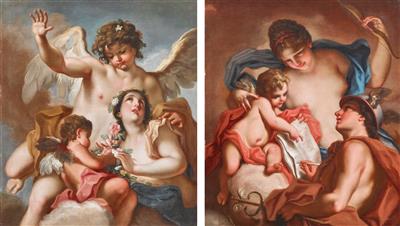Antonio Balestra

(Verona 1666–1740)
Zephyrus, Flora and Cupid; and
Venus, Mercury and Cupid,
oil on canvas, each 112 x 98 cm, framed, a pair (2)
Provenance:
art market, Italy:
Private European collection;
where acquired by the present owner
This unpublished pair of paintings represent the oeuvre of Antonio Balesta at his apogee. The two paintings represent mythological deities posed with graceful elegance while in dialogue. Their expressions reflect the artist’s inclination towards joyful narrative. His particular style combines qualities from the Venetian pictorial tradition with the vivacity of Roman Seicento painting. Moreover, the measured classicism reminiscent of the Bolognese school is expressed in both canvases with clear warm colourism.
The canvas representing Venus, Mercury and Cupid is known in another version formerly in a private collection in London (see L. Ghio and E. Baccheschi, Antonio Balestra, in: R. Bossaglia, G.A Dell’Acqua (eds.), I Pittori Bergamaschi dal XIII al XIX secolo. Il Settecento. II, Bergamo 1989, p. 219, no. 121, p. 284, fig. 3, with uncertain attribution), however, the present painting appears to be of greater quality as to suggest that it is the primary version.
Antonio Balesta trained in Verona with Antonio Bellucci; he sojourned in Rome from 1690, and here frequented the studio of Carlo Maratta, whose influence would prove fundamental to the development of his style. During the first two decades of the eighteenth century, having established himself in Venice and he attained European-wide success by painting mythological subjects. The present two works belong to this period, when Balestra absorbed the influence of his contemporaries in Venice, especially Giovanni Antonio Pellegrini and Jacopo Amigoni. During the 1720s the artist returned to his native city of Verona and in 1725 he received notice of his election to the Accademia di San Luca in Rome.
Documentary sources attest to the presence of various works by Antonio Balestra in Holland. Among these, a mythological series is known that included ‘un magnifico pezzo del Balestra, con Venere e Cupido e un altro pezzo che serve da pendant, dello stesso, rappresentante Zefiro e Flora’ [‘a magnificent piece by Balestra with Venus and Cupid, and another piece that served as its pendant, representing Zephyrus and Flora’] (see F. D’Arcais, in: L. Pascoli, Vite de Pittori, scultori ed architetti viventi dai Manoscritti 1383 1743 della biblioteca comunale ‘Augusta’ di Perugia, Treviso 1981, pp. 139-140, n.42 o p. 117 o pp. 126-127).
Esperto: Mark MacDonnell
 Mark MacDonnell
Mark MacDonnell
+43 1 515 60 403
old.masters@dorotheum.com
09.06.2020 - 16:00
- Stima:
-
EUR 100.000,- a EUR 150.000,-
Antonio Balestra
(Verona 1666–1740)
Zephyrus, Flora and Cupid; and
Venus, Mercury and Cupid,
oil on canvas, each 112 x 98 cm, framed, a pair (2)
Provenance:
art market, Italy:
Private European collection;
where acquired by the present owner
This unpublished pair of paintings represent the oeuvre of Antonio Balesta at his apogee. The two paintings represent mythological deities posed with graceful elegance while in dialogue. Their expressions reflect the artist’s inclination towards joyful narrative. His particular style combines qualities from the Venetian pictorial tradition with the vivacity of Roman Seicento painting. Moreover, the measured classicism reminiscent of the Bolognese school is expressed in both canvases with clear warm colourism.
The canvas representing Venus, Mercury and Cupid is known in another version formerly in a private collection in London (see L. Ghio and E. Baccheschi, Antonio Balestra, in: R. Bossaglia, G.A Dell’Acqua (eds.), I Pittori Bergamaschi dal XIII al XIX secolo. Il Settecento. II, Bergamo 1989, p. 219, no. 121, p. 284, fig. 3, with uncertain attribution), however, the present painting appears to be of greater quality as to suggest that it is the primary version.
Antonio Balesta trained in Verona with Antonio Bellucci; he sojourned in Rome from 1690, and here frequented the studio of Carlo Maratta, whose influence would prove fundamental to the development of his style. During the first two decades of the eighteenth century, having established himself in Venice and he attained European-wide success by painting mythological subjects. The present two works belong to this period, when Balestra absorbed the influence of his contemporaries in Venice, especially Giovanni Antonio Pellegrini and Jacopo Amigoni. During the 1720s the artist returned to his native city of Verona and in 1725 he received notice of his election to the Accademia di San Luca in Rome.
Documentary sources attest to the presence of various works by Antonio Balestra in Holland. Among these, a mythological series is known that included ‘un magnifico pezzo del Balestra, con Venere e Cupido e un altro pezzo che serve da pendant, dello stesso, rappresentante Zefiro e Flora’ [‘a magnificent piece by Balestra with Venus and Cupid, and another piece that served as its pendant, representing Zephyrus and Flora’] (see F. D’Arcais, in: L. Pascoli, Vite de Pittori, scultori ed architetti viventi dai Manoscritti 1383 1743 della biblioteca comunale ‘Augusta’ di Perugia, Treviso 1981, pp. 139-140, n.42 o p. 117 o pp. 126-127).
Esperto: Mark MacDonnell
 Mark MacDonnell
Mark MacDonnell
+43 1 515 60 403
old.masters@dorotheum.com
|
Hotline dell'acquirente
lun-ven: 10.00 - 17.00
old.masters@dorotheum.at +43 1 515 60 403 |
| Asta: | Dipinti antichi |
| Tipo d'asta: | Asta in sala |
| Data: | 09.06.2020 - 16:00 |
| Luogo dell'asta: | Wien | Palais Dorotheum |
| Esposizione: | 02.06. - 09.06.2020 |
